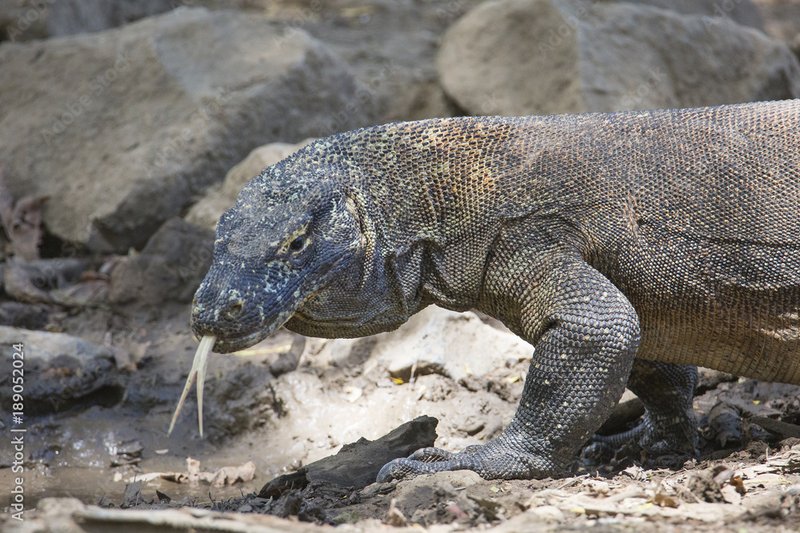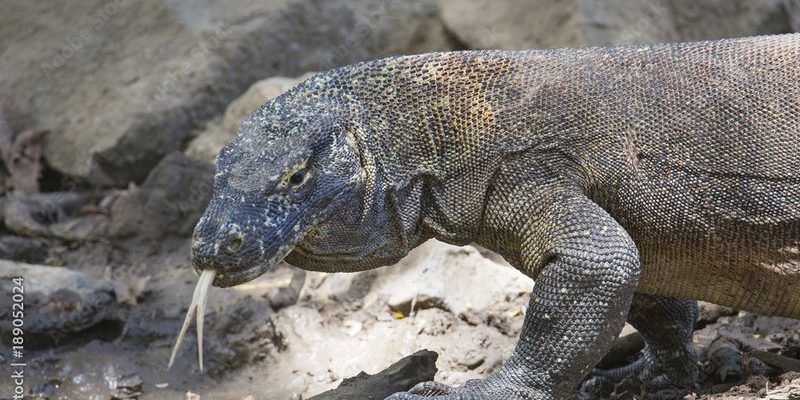
Imagine a creature so large and powerful that it seems straight out of a prehistoric tale. That’s the Komodo Dragon for you. These extraordinary reptiles, native to Indonesia, are unlike any other lizard in the world. They can grow up to 10 feet long and weigh around 150 pounds, making them the largest lizards on Earth. With a combination of strength, speed, and stealth, they are top predators in their natural habitat.
Now, what makes the Komodo Dragon even more intriguing? It’s not just their size; it’s also their unique hunting methods and fascinating behaviors. They have a deadly bite thanks to a cocktail of bacteria in their saliva, which helps them take down prey much larger than themselves. If you’re curious about how these magnificent reptiles live, hunt, and thrive in the wild, stick around. We’re about to dive deep into their world!
Physical Characteristics
When you first see a Komodo Dragon, it’s hard not to be awed by their sheer size and strength. Their skin, rough like a pair of old leather boots, is covered with scales that serve as armor against predators and the environment. The coloration varies from brown to gray and often has hints of yellow and green, which helps them blend into their surroundings—perfect for ambushing prey. You might even catch them basking in the sun, their long tail draped behind them, adding to their intimidating appearance.
One fascinating feature of the Komodo Dragon is its forked tongue, similar to that of a snake. This helps them sense their environment, detecting scents up to 2.5 miles away—a truly remarkable adaptation for a predator. With sharp claws and strong limbs, they are not just impressive to look at; they are built for speed and agility. Even though they can weigh a lot, they can run surprisingly fast, reaching speeds of up to 12 miles per hour over short distances.
Habitat and Distribution
The Komodo Dragon is found mainly on a few islands in Indonesia, including Komodo, Rinca, Flores, and Gili Motang. These islands are part of the Komodo National Park, a protected area that has become essential for the conservation of this species. The environment here is characterized by dry savannas and tropical forests, with plenty of rocky hills and low vegetation. However, despite their strength, Komodo Dragons are now confined to these specific regions.
In their natural habitat, they roam freely, hunting for food and basking in the sun. Unfortunately, due to habitat destruction and human encroachment, their populations have dwindled. Conservation efforts are critical to ensuring their survival, as these magnificent creatures face threats not just from humans but also from natural disasters and climate change, which could alter their habitats.
Diet and Hunting Techniques
The diet of the Komodo Dragon is as fascinating as the creature itself. They are carnivorous and primarily hunt large prey, such as deer, wild boar, and even other smaller Komodo Dragons. What’s particularly interesting is how they employ a strategy similar to that of big cats; they lie in wait for unsuspecting animals to wander into their territory. With lightning speed, they can ambush their prey, using their powerful jaws to deliver a fatal bite.
But it doesn’t stop there. The Komodo Dragon’s bite is notorious for being lethal not just because of its physical strength but also due to the bacteria in its saliva. This mix can cause infection in the prey, eventually leading to its death. The Komodo Dragon has a keen sense of smell, using it to track injured animals from miles away. Once the prey succumbs to infection, the dragon will follow the scent to find its meal, demonstrating a level of intelligence that’s truly remarkable.
Reproduction and Lifecycle
Komodo Dragons have a unique reproductive cycle that sets them apart from many other reptiles. Mating usually occurs between May and August. The female lays around 20 to 30 eggs in September, burying them to protect from predators. This incubation period lasts about 7 to 8 months, with hatchlings emerging in April. These young dragons are on their own as soon as they hatch, climbing trees to avoid being eaten by adults—a natural instinct for survival.
Interestingly, female Komodo Dragons are capable of a reproductive strategy called parthenogenesis. This means they can reproduce without mating, producing viable eggs that develop into young. While this isn’t the norm, it allows them to sustain populations in areas where males might be scarce. Once they reach adulthood, they can live for over 30 years—an impressive lifespan for a reptile.
Conservation Status
Despite their formidable presence, Komodo Dragons are considered vulnerable on the IUCN Red List. Their populations have decreased significantly over the years due to habitat loss, illegal hunting, and the impacts of climate change. Conservation efforts are in place to protect their habitats and ensure that these unique reptiles continue to thrive. The Komodo National Park plays an essential role in this conservation, providing a safe haven where they can live and reproduce without the threat of human interference.
Various organizations are also involved in educating local communities on the importance of preserving the Komodo Dragon. Ecotourism has become an essential aspect of their conservation strategy, allowing visitors to appreciate these incredible creatures up close while also contributing to their protection. Without these efforts, we might lose this extraordinary species forever, which would be a significant loss for biodiversity.
Interesting Facts
| Scientific Name: | Varanus komodoensis |
| Length: | Up to 10 feet |
| Weight: | Up to 150 pounds |
| Habitat: | Indonesian Islands |
| Diet: | Carnivorous (eats deer, birds, etc.) |
| Speed: | Up to 12 mph |
| Lifespan: | Over 30 years |
Komodo Dragons in Culture
Throughout history, the Komodo Dragon has captured the imagination of many. They have been featured in documentaries, movies, and even folklore. In Indonesia, locals often tell tales of these dragons as mystical creatures, adding to their allure. Their strange appearance and fascinating behaviors make them a popular topic for educational programs, sparking interest in reptilian biology and conservation among younger generations.
Moreover, the attention brought to Komodo Dragons through media and tourism has prompted global initiatives for their preservation. As people become more aware of the challenges these animals face, they’re inspired to take action, whether it’s through supporting wildlife conservation organizations or participating in ecotourism. This collective effort is vital for ensuring that the next generation gets to experience the wonder of the Komodo Dragon.
FAQ
What do Komodo Dragons eat?
Komodo Dragons are carnivorous and have a diverse diet that includes large herbivores such as deer and wild boar. They will hunt and ambush their prey with great skill, using their powerful jaws to deliver a fatal bite. They also scavenge on carrion, which makes them quite versatile as hunters.
Are Komodo Dragons dangerous to humans?
While Komodo Dragons are capable of inflicting serious harm, attacks on humans are rare. However, they are still considered dangerous animals due to their size and strength, along with the potentially lethal effects of their saliva. It’s important to respect their space in the wild and follow safety guidelines in their habitat.
How long do Komodo Dragons live?
In the wild, Komodo Dragons can live for over 30 years. This longevity is largely due to their position as apex predators and their ability to adapt to changing environments. Captive Komodo Dragons may live even longer if provided with the right care and diet.
Where can I see Komodo Dragons?
The best place to see Komodo Dragons in their natural habitat is in Komodo National Park in Indonesia. Here, you can take guided tours to observe them while respecting their environment. Some zoos and wildlife parks around the world also have Komodo Dragons as part of their exhibits.
How do Komodo Dragons reproduce?
Komodo Dragons mate during the months of May to August. Females lay around 20 to 30 eggs, which they bury for protection. The eggs incubate for about 7 to 8 months before the hatchlings emerge. Interestingly, Komodo Dragons can reproduce through parthenogenesis, allowing females to produce offspring without a mate in certain conditions.
What is the biggest threat to Komodo Dragons?
The biggest threats to Komodo Dragons include habitat loss due to human activities like deforestation, hunting, and climate change. These factors have contributed to their declining population, making conservation efforts critical to their survival.
Do Komodo Dragons have any natural predators?
Adult Komodo Dragons have few natural predators; however, they can be threatened by larger animals, including other Komodo Dragons, especially young hatchlings. Being born instinctively vulnerable, hatchlings often climb trees to avoid being eaten.
Can Komodo Dragons swim?
Yes, Komodo Dragons are surprisingly good swimmers. They can easily swim between islands, which is quite beneficial for hunting and exploring their territories. This ability also allows them to escape threats when necessary.
How do conservation efforts help Komodo Dragons?
Conservation efforts help Komodo Dragons by protecting their natural habitats from development and hunting. National parks and wildlife organizations work together to create management plans that support both the dragons and their ecosystems, ensuring that these incredible creatures can thrive for future generations.
What role do Komodo Dragons play in their ecosystem?
As apex predators, Komodo Dragons play a vital role in their ecosystems by helping to regulate the populations of other species in their environment. Their hunting activities contribute to maintaining a balance, which is essential for healthy habitats. This balance demonstrates the interconnectedness of all living things within an ecosystem.
Are Komodo Dragons social animals?
Komodo Dragons are generally solitary creatures, coming together primarily for mating or feeding. However, they may gather around a carcass to feed, displaying a level of social interaction. While they don’t form packs, they do communicate through body language and scent, which is crucial for their interactions.
What unique adaptations do Komodo Dragons have?
Komodo Dragons possess several unique adaptations that aid in their survival. Their keen sense of smell allows them to detect scents from long distances, while their powerful jaws and strong limbs enable them to hunt large prey effectively. Additionally, their rough, scaly skin helps protect them from injury. These adaptations collectively make them one of the most fascinating reptiles on the planet.

